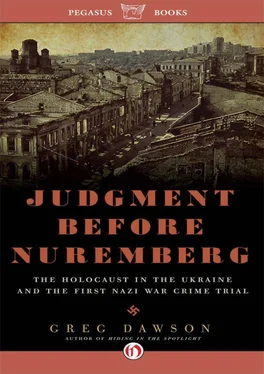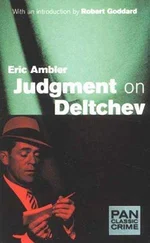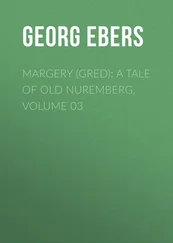“I remember it was very bleak, very quiet, and we did not at all like this feeling…. We had not gone more than a hundred meters when we saw… a human leg, a bare leg, bootless, projecting out of the snow, just as if its owner had dived off the side of the ravine… into the snow and had stuck there in the drift, his leg pointing upward.”
Finally, the rollercoaster road rises to a wide plateau and the memorial—a soaring white stone arch tapering to a flame shape, which shelters two tablets like those Moses delivered, inscribed with “Thou Shall Not Kill” in myriad languages. Underground is a candle-lit space where the names of 4,300 of the 16,000 victims are etched on marble walls and the ceiling is the black winter sky brilliant with stars—supposedly the last thing the condemned Jews saw, though the designer’s anodyne vision surely belies the truth. For most Jews who died here, the final image fixed in their minds likely was the bottom of a ravine filled with corpses.
“All the skeletons embrace one another in the ground,” wrote poet Yevgeny Yevtushenko in The Apple Trees of Drobitsky , written in 1989, twenty-eight years after publication of his celebrated Babi Yar , about the slaughter of 34,000 in the ravines near Kiev. Few outside Ukraine know of the killings at Drobitsky or of Yevtushenko’s poem about the earth there “endowed by the dead.” The apple trees of Drobitsky, adjacent to the memorial, still bear fruit. I nearly lost a camera to thieves there on my 2006 visit—a material loss so embarrassingly negligible on that sacred-profane ground that I hesitate to mention it.
My mother escaped the march to Drobitsky before reaching the ravine, but her sister, Frina, most likely did not—yet she survived. Like I’ve said above, Frina has never said how she escaped, but survivor testimony from other yars in Ukraine lends credence to Yevtushenko’s poetic vision in Apple Trees when he asks a teenager named Ruvin to “tell us how, naked as the day you were born, all smeared with blood, your face drained bloodless, you crawled out from under, shoving bodies aside.”
Behind the arch on a lower plateau is a block of reddish Zhitomyr granite, a monument to the victims of the entire Holocaust, with six notches on the side for the six million. It was erected in 1998 to correct—or supplement—the monument next to it put up in 1955 by Soviet authorities, whose official state denial of a Jewish Holocaust is reflected in the cryptic inscription on a small weathered obelisk: “The victims of the fascist terror 1941–1942 lie here.”
Just beyond this second plateau, the ground starts to slope sharply toward the bottom of the ravine. I didn’t go there on my first visit. I had begun walking down the slope, gravity and momentum quickening my pace, pulling me headlong toward the pit. But something made me stop after thirty yards. I turned and walked along the edge of the abyss. Looking down, I could see discarded tires in the tall grass and brambles, and I could walk no farther. The tour guide at the memorial, a young woman named Irina, said that sometimes on a summer day when she looks at the ravine, “I see strawberries and cranberries growing. It reminds me of blood.” She has a recurring nightmare: “Guns firing, children falling, lying in blood. I am inside a huge building. When I want to leave I can’t find a door. Someone tells me, ‘Use a rope.’ Then I wake up.”
In 2006, Irina was in her fifth year as a guide at Drobitsky Yar. I wondered why she chose to return every day to a place that will give her visions of bloody strawberry fields forever. “I somehow feel related to all those visiting here,” she said.
So it was both homecoming and “family” reunion when, four years later, in 2010, I knocked on the office door at the memorial and Irina answered. She wondered something similar about me—why had I come back? To complete my journey, I told her. To walk from the ghetto to the memorial, and then to the bottom of the ravine. We laughed over memories of the first visit when I chased two boys through the apple trees in pursuit of my stolen camera, only to corner them empty-handed—and how Irina had gone into the orchard and returned forty-five minutes later with my camera and a craven apology from the boys. After your walk in the ravine, she said, we shall have hot tea.
There are steps going down one side of the ravine to a path on the bottom leading to steps going back up the other side in a rough U-shape. I started down the left side, treading gingerly as it was hard to make out the steps in the fresh snow. I descended deeper and deeper and began to experience—in the words of Dr. Karandash—“the feeling of being closed in between the walls of the ravine.” I was now far below the precipice from which I had stared down into the pit. I was looking up the steep slope at treetops and sky. I was in the crevasse with Dr. Karandash as he heard “a terrible sound… a high scream between the ice walls. I imagined at that moment the sound was made by all those people there, those souls in anguish crying in the night, crying at one moment all around us so the sound would seem to shatter the ice and then, diminishing as it rushed upwards, skywards, a long-drawn spirit wail ascending into the black frozen heaven.”
The report from Soviet authorities who unearthed bodies from killing fields across Kharkov eerily echoes Blunden’s fiction:
“In most graves they lay in extreme disorder, fantastically intertwined, forming tangles of human bodies defying description. The corpses lay in such a manner that they can be said to have been dumped or heaped but not buried in common graves. The fact that before being murdered, Soviet citizens were stripped of their clothes and footwear is fully confirmed by the medico-legal examinations. During exhumations the experts in most cases discovered naked or half-naked bodies.”
I reached the bottom of the ravine and stopped. Suddenly, I was angry at how peaceful it was, how beautiful, under the new snow. It seemed a negation of what happened here, a grotesque travesty of truth that this beauty and serenity could muffle the high screams of my grandparents and great-grandparents whose bones lay here, fantastically intertwined.
“That is the one thing I cannot stop thinking about—how they died,” my mother has said to me many times. “I don’t know how they died.”
I have known for some years, with reasonable certainty, how her family died. But I have never responded to her lament by offering the information, because I do not believe that she really wants to know—or rather, she dreads being told what she already must know but has relegated to a black box deep in her subconscious.
In September 1943, with the Nazis in full retreat from Ukraine, the District Commission for Determination and Investigation of the Crimes of the German-Fascist Invaders and their Collaborators issued its report, “On the Mass Shooting of Jews by the German Murderers in the Drobitzki Valley.” The eleven-member commission included military, political, academic, and religious representatives from the Kharkov region.
“The Commission opened up two pits near the village of Rogan in the valley of Drobitzki, one of them 100 meters long and 18 to 20 meters wide, and second 60 meters long and 20 meters wide. According to the finding of the Expert Medical Commission, upward of 15,000 bodies were buried in these pits. Five hundred were removed from the pits, of which 215 were submitted to medico-legal examination. They included the bodies of 83 men, 117 women, and 60 children and infants. It was established that the cause of death of almost all these persons was a wound and hole in the back of the skull caused by the passage of a bullet. This indicated that the shooting was carried out from behind the person to be killed and from a short distance away.”
Читать дальше












